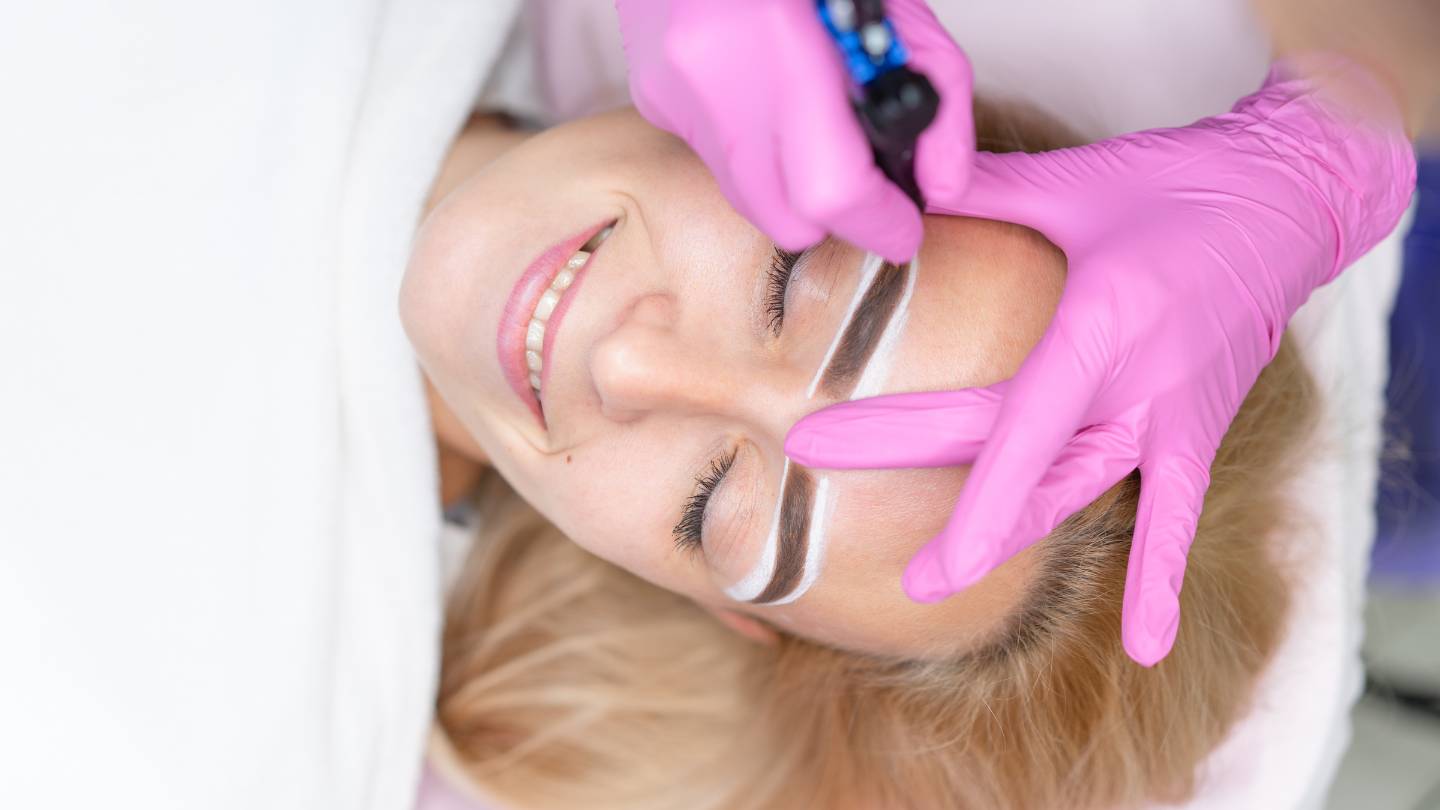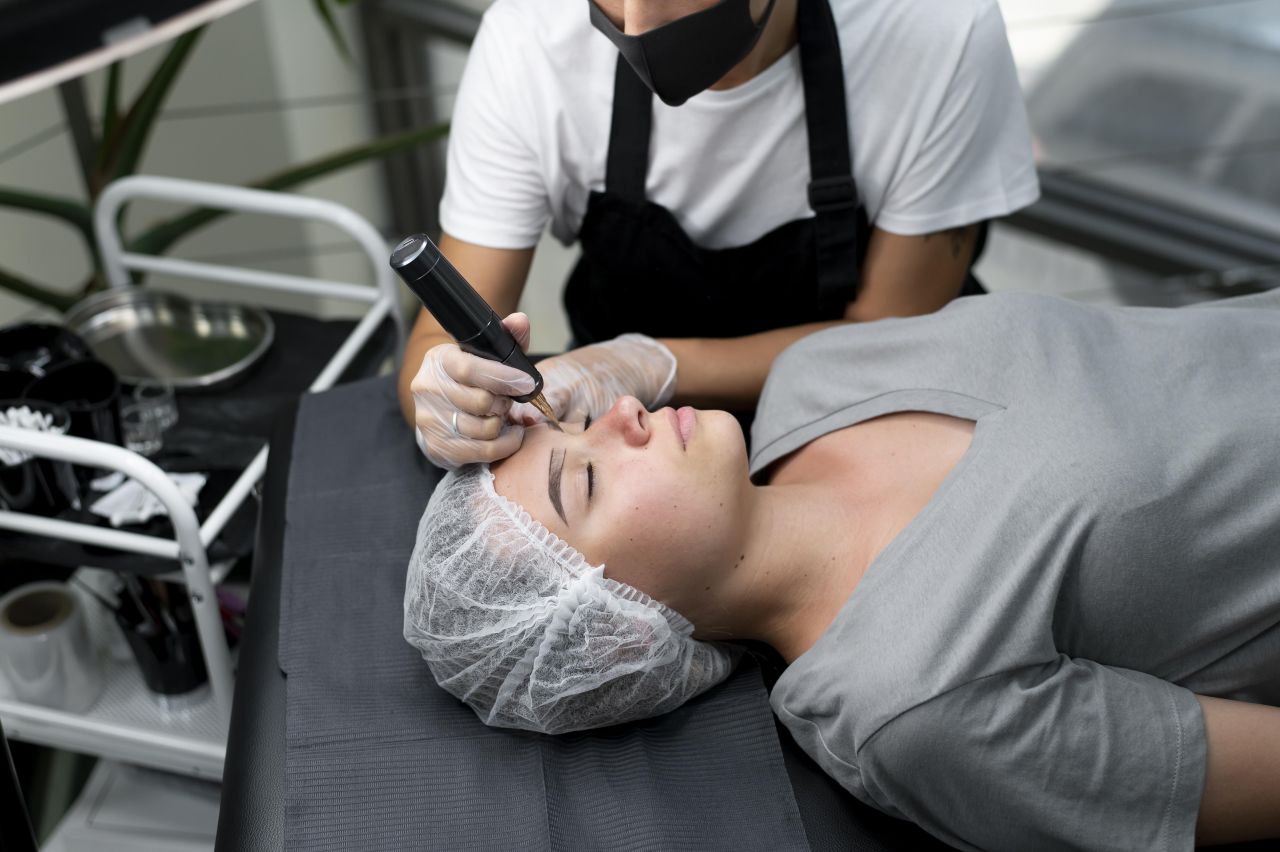Perfectly shaped eyebrows can enhance your facial features, but achieving them daily can be time-consuming. Imagine waking up with brows that already look flawless—without the need for pencils, powders, or gels.
If this sounds appealing, microblading might be the solution for you. This semi-permanent cosmetic technique offers natural-looking, low-maintenance brows without the commitment of a traditional tattoo.
This guide will discuss microblading, its benefits, and the necessary pre- and post-procedure care to help you decide if this brow-perfecting treatment is right for you.
Let’s get straight to the point
Microblading is a semi-permanent cosmetic procedure that mimics natural eyebrow hairs using fine strokes of pigment. It’s a time-saving, low-maintenance alternative to daily eyebrow makeup, offering natural-looking results that last 1-3 years.
The process involves a handheld tool with thin needles and requires pre- and post-care to ensure optimal healing and appearance. Unlike eyebrow tattoos, microblading is less permanent and fades gradually.
Though generally safe, risks like allergic reactions or infections can be avoided with proper care and a certified technician.
How Does Microblading Work?
Microblading involves using a handheld tool with fine, needle-like blades. These needles make tiny incisions in the skin where pigment is applied to mimic real eyebrow hairs. Each session typically lasts one to three hours, depending on the complexity and desired results.
Though microblading isn’t permanent, it lasts longer than your typical makeup routine—around one to three years. However, the procedure requires touch-ups every few weeks initially and then periodically to maintain the appearance.
Pre-Procedure Care
Before your appointment, there are a few things to keep in mind:
- Avoid aspirin, alcohol, and vigorous exercise for at least 24 hours before the procedure.
- Stay hydrated and moisturise your skin.
- If you have sensitive skin, consult your technician about a patch test for the pigment.
Post-Procedure Care
After the procedure, your skin will be sensitive, and it’s important to follow proper aftercare to ensure the best healing and lasting results. Here’s how to care for your microbladed brows:
- Avoid touching the brows for the first few days to prevent infection.
- Apply the recommended healing balm as instructed by your technician.
- Reapply the balm twice daily, but be careful not to overdo it, as too much can dilute the pigment.
- Avoid washing your face or getting your brows wet for at least 10-14 days after the procedure.
- Stay away from makeup on the brow area for the first ten days to prevent infection.
- Avoid alcohol, aspirin, and ibuprofen for the first 24 hours to prevent excessive thinning of the blood.
Benefits Of Microblading
Microblading offers several benefits for those looking to enhance their eyebrows:
- Time-saving: No more spending precious time filling in your brows daily. Microbladed brows are ready the moment you wake up.
- Natural look: The fine strokes used in microblading create a natural, subtle look that blends with your existing eyebrow hair.
- Boosts confidence: Well-defined brows frame the face, giving you a polished appearance and boosting self-confidence.
- Lasting results: Though semi-permanent, the results of microblading last one to three years, depending on your skin type and lifestyle.
- Cost-effective: Consider the money saved on brow pencils, powders, gels, waxing, and tweezing—microblading is a worthwhile investment.
- Low maintenance: Once your brows heal, you can enjoy your routine without worrying about smudging or reapplying brow products.
- Water-resistant: Whether swimming, sweating, or just going about your day, microbladed brows stay put.
- Restores brows: Microblading is ideal for those who’ve lost their brows due to medical treatments like chemotherapy or alopecia.
The Microblading Process
Tools And Technique
During a microblading session, a technician uses a handheld tool of ultra-thin needles. These needles puncture the skin in tiny strokes to deposit pigment.
The strokes mimic the natural growth pattern of your eyebrow hairs, resulting in a subtle, natural look. The whole process, including a consultation, can take one to three hours.
The Procedure
- The technician will first map out your brow shape based on your facial proportions.
- Once you approve the shape, a numbing cream is applied to minimise discomfort during the procedure.
- The microblading process begins, with the technician making fine, hair-like strokes and filling them with pigment.
- After the procedure, you’ll receive specific aftercare instructions to follow for the next few weeks.
Healing And Touch-Ups
After the initial procedure, expect a healing period of 7-14 days. During this time, your brows may appear darker and thicker than anticipated.
Some scabbing is normal as the skin heals. After around a month, the true colour and shape will settle in.
A touch-up session is usually required 4-6 weeks after the initial procedure to ensure the pigment sets correctly and to make any necessary adjustments.
Risks And Side Effects Of Microblading
While microblading is generally safe when performed by a qualified technician, it’s essential to be aware of potential risks:
- Allergic reactions: Some individuals may experience an allergic reaction to the pigment used in microblading. If you have sensitive skin, always ask for a patch test.
- Infection: Like any procedure that involves breaking the skin, there’s a risk of infection. Ensure that a certified technician performs the procedure in a sterile environment.
- Scarring can occur if the technician goes too deep or the skin doesn’t heal properly.
- Pigment fading or colour change: The pigment may change over time. Regular touch-ups help maintain the desired look.
Maintaining Your Microbladed Eyebrows
To keep your microbladed eyebrows looking their best, follow these simple tips:
- Avoid sun exposure: Prolonged exposure to the sun can cause the pigment to fade faster. Use sunscreen on your brows when outdoors.
- Skip harsh products: Avoid using exfoliants or harsh skincare products around the brow area.
- Keep them moisturised: Applying a healing balm or moisturiser can help maintain the pigment and prevent drying.
Conclusion
Microblading is a revolutionary technique for achieving natural-looking, perfectly shaped eyebrows without the daily hassle of makeup application. From its semi-permanent nature to its realistic results, microblading can transform your look while saving you time and effort.
Whether you’re looking to fill in sparse brows or completely reshape them, microblading is a versatile, long-lasting solution. Proper care and periodic touch-ups keep your brows fresh and defined for years.
FAQs About Eyebrow Tattoo
What Exactly Is The Most Natural Eyebrow Tattoo Technique?
The most natural eyebrow tattoo technique is known as microblading. It involves using a handheld tool with tiny needles to create small, hair-like strokes that mimic the appearance of natural eyebrows.
How Long Does A Natural-Looking Eyebrow Tattoo Last?
Microbladed eyebrows typically last anywhere from one to three years, depending on skin type, lifestyle, and aftercare. Touch-up sessions may be required to maintain the desired look.
Is Microblading Suitable For All Skin Types?
Microblading is suitable for most skin types, including oily, dry, and combination. However, consulting with a professional technician who can assess your skin’s suitability and provide personalized advice is essential.
Does Microblading Hurt?
While discomfort levels vary from person to person, most clients describe the sensation as mild to moderate. Topical numbing cream is applied before the procedure to minimize any potential discomfort.
Can I Still Shape My Eyebrows After Getting A Microblading Treatment?
You can still groom and shape your eyebrows after getting microblading done. However, it’s essential to be cautious and avoid plucking or waxing over the tattooed area to maintain the desired shape and prolong the tattoo’s longevity.


